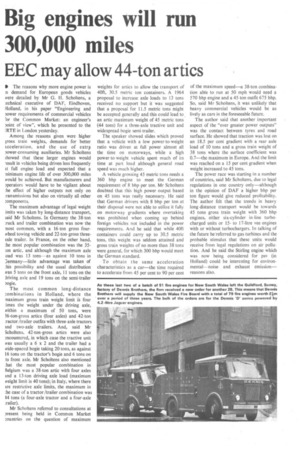Big engines will run 300,000 miles
Page 33

If you've noticed an error in this article please click here to report it so we can fix it.
EEC may allow 44-ton artics
lb The reasons why more engine power is n demand for European goods vehicles were .detailed by Mr G. H. Scholtens, a :echnical executive of DAF, Eindhoven, Holland, in his paper "Engineering and Dower requirements of commercial vehicles or the Common Market: an engineer's joint of view", which he presented to the [RTE in London yesterday.
Among the reasons given were higher ;miss train weights, demands for better acceleration, and the use of extrp. Dower-consuming auxiliaries. Mr Scholtens ;howed that these larger engines would result in vehicles being driven less frequently at full engine load and expected that a niniinum engine life of over 300,000 miles would be achieved. But manufacturers and operators would have to be vigilant about :he effect of higher outputs not only on :ransmissions but also on virtually all other :omponents.
The maximum advantage of legal weight imits was taken by long-distance transport, said Mr Scholtens. In Germany the 38-ton :ruck and trailer combination was now the nost common, with a 16-ton gross fourwheel towing vehicle and 22-ton-gross threeaxle trailer. In France, on the other hand, the most popular combination was the 35ton artic, and although the maximum axle load was 13 tons as against 10 tons in :lermany—little advantage was taken of :his possibility and the usual distribution was 5 tons on the front axle, 11 tons on the iriving axle and 19 tons on the semi-trailer bogie.
The most common long-distance :ombinations in Holland, where the maximum gross train weight limit is four :imes the weight under the driving axle, within a maximum of 50 tons, were 36-ton-gross artics (four axles) and 42-ton tractor /trailer outfits with three-axle tractors and two-axle trailers. And, said Mr Scholtens, 42-ton-gross artics were also mcountered, in which case the tractive unit was usually a 6 x 2 and the trailer had a wide-spaced bogie taking 20 tons, as against 16 tons on the tractor's bogie and 6 tons on its front axle. Mr Scholtens also mentioned :hat the most popular combination in Belgium was a 38-ton artic with four axles and a 13-ton driving axle load (maximum weight limit is 40 tons); in Italy, where there are restrictive axle limits, the maximum in the case of a tractor /trailer combination was 44 tons (a four-axle tractor and a four-axle trailer).
Mr Scholtens referred to consultations at present being held in Common Market countries on the question of maximum weights for artics to allow the transport of 40ft, 30.5 metric ton containers. A 1964 proposal to increase axle loads to 13 tons received no support but it was suggested that a proposal for 11.5 metric tons might be accepted generally and this could lead to an artic maximum weight of 45 metric tons (44 tons) for a three-axle tractive unit and widespread-bogie semi-trailer.
The speaker showed slides which proved that a vehicle with a low power-to-weight ratio was driven at full power almost all the time on motorways, while a high power-to-weight vehicle spent much of its time at part load although general road speed was much higher.
A vehicle grossing 45 metric tons needs a 360 bhp engine to meet the German requirement of 8 bhp per ton. Mr Scholtens doubted that this high power output based on 45 tons was really necessary. He said that German drivers with 8 bhp per ton at their disposal were not able to utilize it fully on motorway gradients where overtaking was prohibited when coming up behind foreign vehicles not included in the power requirements. And he said that while 40ft containers could carry up to 30.5 metric tons, this weight was seldom attained and gross train weights of no more than 38 tons were general, for which 300 bhp would meet the German standard.
• To obtain the same acceleration characteristics as a car—the time required to accelerate from 45 per cent to 90 per cent of the maximum speed—a 38-ton combination able to run at 50 mph would need a 570 bhp engine and a 45-ton outfit 675 bhp. So, said Mr Scholtens, it was unlikely that heavy commercial vehicles would be as lively as cars in the foreseeable future.
The author said that another important aspect of the "ever greater power outputs?' was the contact between tyres and road surface. He showed that traction was lost on an 18.5 per cent gradient with a rear axle load of 10 tons and a gross train weight of 38 tons where the surface coefficient was 0.7—the maximum in Europe. And the limit was reached on a 15 per cent gradient when weight increased to 45 tons.
The power race was starting in a number of countries, said Mr Scholtens, due to legal regulations in one country only—although in the opinion of DAF a higher bhp per ton figure would give reduced profitability. The author felt that the trends in heavy long-distance transport would be towards 45 tons gross train weight with 360 bhp engines, either six-cylinder in-line turbocharged units or 15to 17-litre vee engines with or without turbochargers. In talking of the future he 'referred to gas turbines and the probable stimulus that these units would receive from legal regulations on air pollution. And he said the Stirling engine which was now being considered for psv (in Holland) could be interesting for environmental—noise and exhaust emission— reasons also.




































































































